Rightsizing Lab Space Allocations
At many institutions, there is a mismatch between principal investigator (PI) lab allocations and their actual space needs. In some cases, PIs have more space than their current projects require. In others, PIs lack sufficient space to conduct their research. Along with inhibiting research progress and growth, these discrepancies also increase space inefficiencies and institutional costs since labs are expensive to build and maintain.
This interactive article helps leaders establish procedures for optimizing initial lab space allocations to align with immediate PI needs and fine-tuning allocations over time based on research productivity metrics.
The efficiency imperative
As institutional budgets tighten, campus leaders are facing growing pressure to increase space efficiency and reduce facilities costs. This is especially true for research labs since they are expensive to maintain and in such high demand.
However, optimizing lab space allocations is easier said than done. PIs accumulate lab space over the course of their career, but rarely forfeit it—even when their research needs change. As a result, there is often a mismatch between PI lab allocations and actual space needs.

Source: EAB interviews and analysis
Institutions have two options for better aligning lab space allocation to researcher needs:
Most leaders have focused on the former, but many have struggled to perfect initial allocations since they are constrained by current lab availability and limited information about new hire lab needs. And since PI space needs change over their career, optimizing initial allocations does not guarantee PIs will have the right space in the long run.
As a result, some leaders are turning their attention to the latter option—fine-tuning allocations by using incentives to drive better space use over time. This approach requires more hands-on management and runs counter to most institutions’ culture of perpetual space ownership. But when properly implemented, it allows institutions to align lab allocations with changing researcher needs and avoid situations where PIs have excess or insufficient space.
Ultimately, to maximize lab space efficiency and ensure PIs have the right space for their research, leaders should use both approaches simultaneously.
Part one: Rightsize initial allocation based on researcher needs
Improving initial allocations helps leaders save space by giving PIs the right square footage based on their immediate research needs. Yet, leaders often struggle to accurately estimate how much lab space to allocate. Many use formulas to calculate initial allocations based on factors like the space intensity of the discipline or headcount.
But these formulas rarely account for the variation in PI space needs within the same discipline. For example, a formula might allocate an environmental biologist and bioinformatician the same square footage despite them having very different space needs. To counter this, some schools are adopting a more discipline-agnostic allocation approach.
In lieu of an allocation formula, the University at Albany created a taxonomy of 25 lab space types. Each type is based on three factors: the nature of the research activity, the needed space setup, and the team size. This allows unit leaders to personalize a PI’s upfront allocation based on a combination of factors that together provide a more accurate prediction of lab space needs than discipline alone. And it in turn helps them minimize the backend customization required.
After designing this taxonomy, Albany created square footage guidelines and diagrams for each lab type, which increase transparency and reduces the likelihood of allocation inequities.
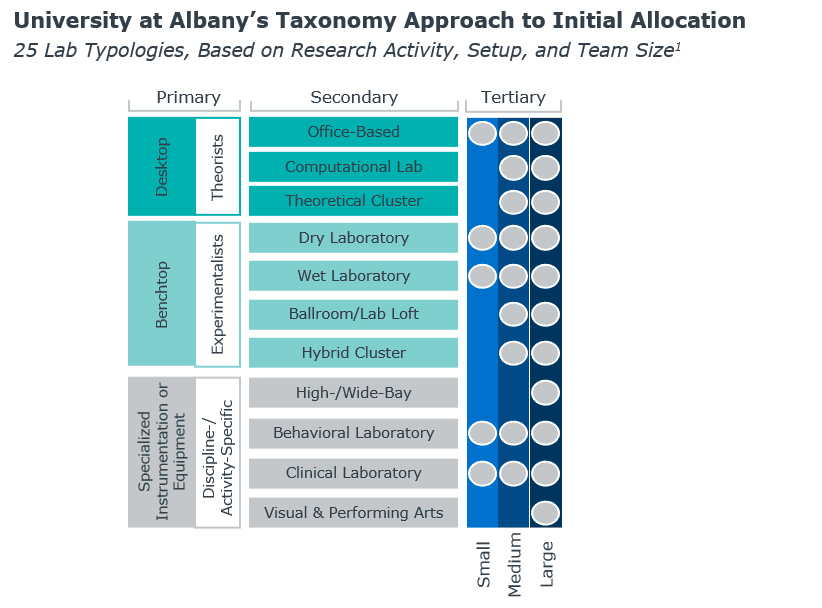
Source: University at Albany, Albany, NY; EAB interviews and analysis.
1) Team size is based on number of PIs, staff, postdocs, and graduate, doctoral, and undergraduate students. Source: University at Albany, Albany, NY; EAB interviews and analysis.
Part two: Fine-tune allocation over time based on researcher productivity
Improving initial lab space allocations helps institutions preempt inefficiency by giving PIs the right amount of space based on their immediate needs. But since PI space needs constantly change as their research evolves, institutions cannot stop at optimizing their initial allocation. Instead, they should follow six steps to continuously fine-tune lab allocations over time.
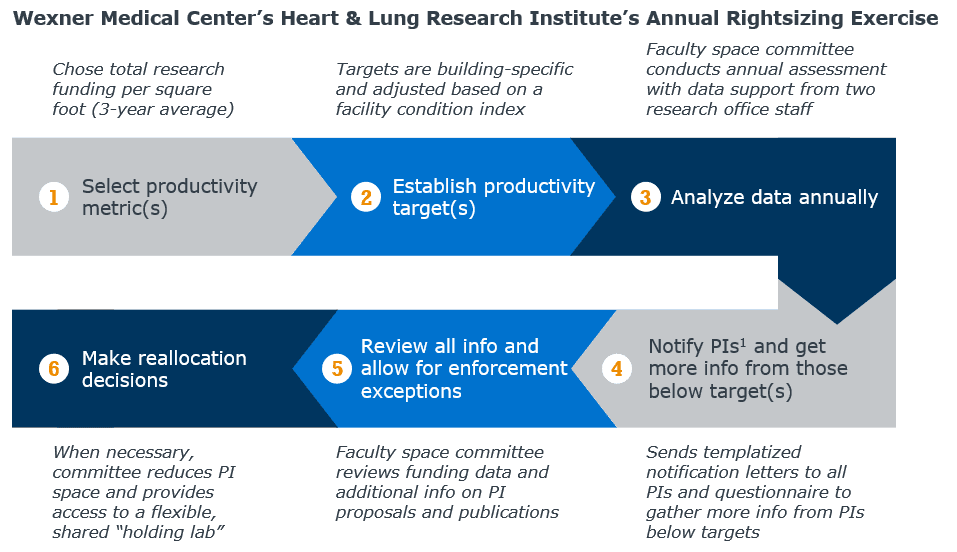
Source: Ohio State University Wexner Medical Center Heart & Lung Research Institute, Columbus, OH; EAB interviews and analysis.
Many schools struggle with the very first step in the fine-tuning process: selecting agreed-upon productivity metrics. Leaders can choose from a range of options, but they each have tradeoffs. Non-financial metrics are more straightforward to calculate but harder to standardize. They also do not provide leaders with the best gauge for assessing whether a PI has used their space productively.
In contrast, financial metrics are more complex to calculate since they require combining data from multiple internal systems and accounting for annual funding variability. However, they provide leaders with a more precise approximation of space productivity.
Range of potential non-financial and financial metrics
Ranked from easiest to measure to most complex
-
Size
- FTEs committed to research
- Undergraduate and graduate students engaged
-
Research output
- Publications, citations, patents
- Performances and presentations
- Favorable reviews from funding agencies
- Previous funding track record
-
Funding-to-space ratio*
- Total research expenditures per square foot
- Total extramural funding per square foot
-
Cost-to-space ratio*
- Facilities and administrative funding (F&A) per square foot
- Modified total direct costs per square foot
*Given inter-annual productivity variability, financial metrics should be based on a 3- or 5-year moving average.
When choosing productivity metrics, leaders should consider which best align with their institutional goals. For example, institutions just beginning to increase campus research activity are well-suited to use size or output metrics. If climbing the Higher Education Research and Development (HERD) rankings is an institution’s top priority, then expenditures is a good option. Or if an institution’s primary goal is increasing space utilization to better cover facilities costs, then F&A per square foot may be the best choice.
Leaders must also consider disciplinary differences when selecting metrics. Since research funding availability varies by discipline, units and PIs are unlikely to ever agree on a single definition of research productivity.
East Carolina University therefore allows units to choose their own metrics from an approved list, although they must select at least one financial measure of productivity. The academic deans and University Space Committee then review unit selections prior to signoff to standardize them across disciplines and provide an accountability check.
East Carolina University’s Research Space Productivity Expectations
-
Expects productivity measures and benchmarks to vary between and among disciplines
-
Provides units with list of potential financial and non-financial measures to choose from
-
Financial measures must be one part of overall assessment of productivity
-
Unit measurement schemes are approved by deans and/or University Space Committee
Source: East Carolina University, Research Space Allocation; EAB interviews and analysis.
Access East Carolina’s research space allocation policy
Besides allowing units to select their own metrics, leaders can also adjust their productivity targets by discipline. For example, using national benchmarking data on total research funding per square foot of research space to set different benchmarks for each discipline.
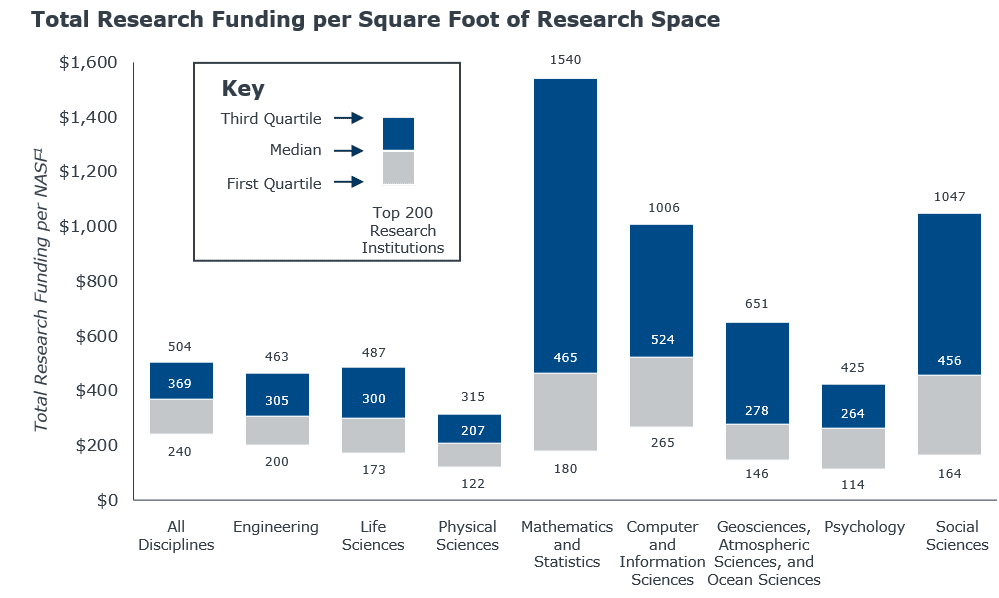
Source: National Science Foundation, Higher Education Research and Development Survey FY17; National Science Foundation, Science and Engineering Research Space FY17; EAB interviews and analysis.
This benchmarking data is a useful starting point for institutions discussing productivity metrics. But since institutions cannot increase researcher productivity overnight, leaders should also review their institution-specific funding data and start by setting realistic targets based on their PIs’ track records. Over time, leaders can then adjust their benchmarks to better align with national standards.
Institutions should also consider adjusting productivity targets based on space quality. For example, the University of Virginia’s School of Medicine uses three different targets depending on whether the lab is in very good condition (blue), fair condition (medium teal), or poor condition (light teal). By setting more aggressive targets for superior labs, leaders can ensure occupants make the most of high-value campus space. This also incentivizes PIs to grow funding so they can access nicer lab space in the future.
-
$369
the median research funding per square foot of research space for the 200 largest US research institutions
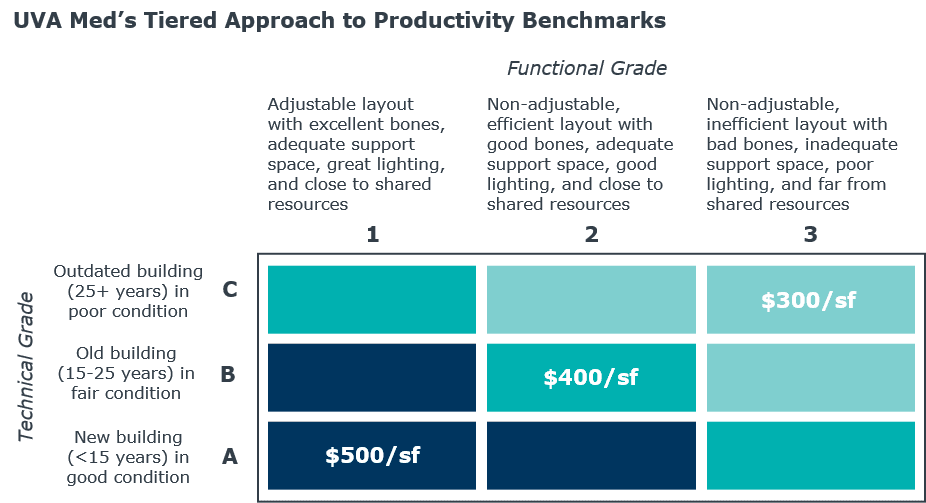
Source: University of Virginia, Charlottesville, VA; EAB interviews and analysis.
Access UVA School of Medicine’s full policy
After selecting productivity metrics and setting targets, institutions must hold campus stakeholders accountable for hitting these benchmarks. Leaders should therefore enforce productivity targets at three levels: the college, department, and individual investigator. This prevents unproductive units and PIs from flying under the radar and therefore helps maximize space efficiency.
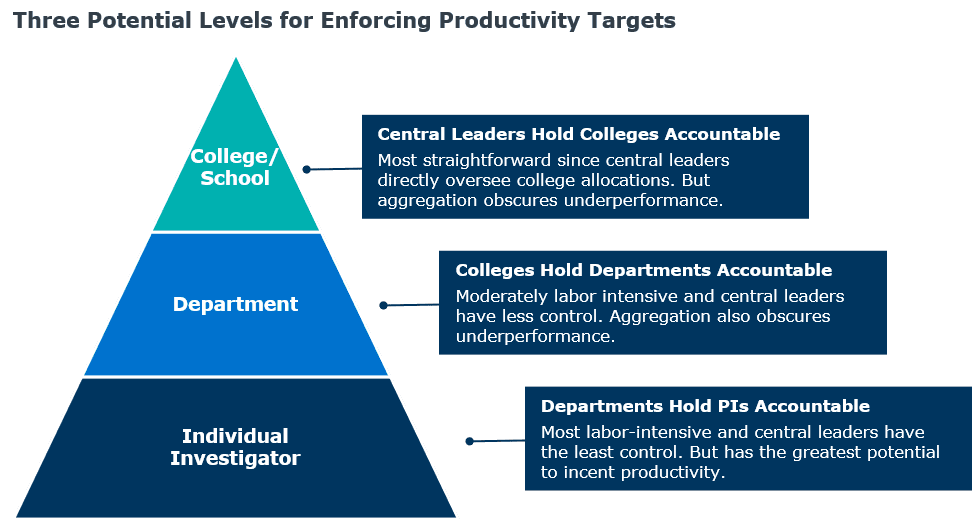
Source: EAB interviews and analysis.
Increasing lab space efficiency is not an easy task. But given growing budgetary constraints and competition for federal research funding, leaders must take steps to rightsize lab allocations. This will ultimately enable institutions to maximize the value of their existing lab space and incentivize greater research productivity.
This resource requires EAB partnership access to view.
Access the research report
Learn how you can get access to this resource as well as hands-on support from our experts through Strategic Advisory Services.
Learn More